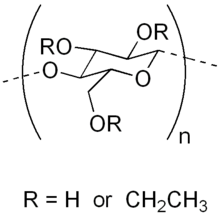Ethyl cellulose
This article needs additional citations for verification. (January 2014) |

| |
| Names | |
|---|---|
| Other names
Cellulose, ethyl ether; ethylated cellulose; ethylcellulose; E462
| |
| Identifiers | |
| ChemSpider |
|
| ECHA InfoCard | 100.126.240 |
| E number | E462 (thickeners, ...) |
| UNII | |
CompTox Dashboard (EPA)
|
|
| Properties | |
| variable | |
| Molar mass | variable |
Except where otherwise noted, data are given for materials in their standard state (at 25 °C [77 °F], 100 kPa). | |
| Infobox references | |
Ethyl cellulose (or ethylcellulose) is a derivative of cellulose in which some of the hydroxyl groups on the repeating glucose units are converted into ethyl ether groups. The number of ethyl groups can vary depending on the manufacturer.
It is mainly used as a thin-film coating material for coating paper, vitamin and medical pills, and for thickeners in cosmetics and in industrial processes.
Food grade ethyl cellulose is one of few non-toxic films and thickeners which are not water soluble. This property allows it to be used to safeguard ingredients from water.[1]
Ethyl cellulose is also used as a food additive as an emulsifier (E462).
See also[]
References[]
- ^ "Ethylcellulose". www.dow.com.
Categories:
- Cellulose
- Food additives
- Excipients
- Cellulose ethers
- E-number additives
- Polymer stubs